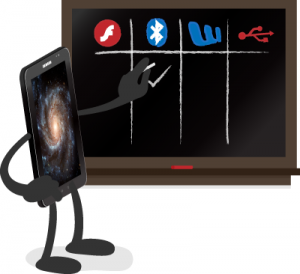-
-
products
-
resources
-
support
-
company
-
Illustration: Gordon McAlpin With the announcement and impending release of the iPad 3, it’s important to point out that as advanced as tablets are, there are still things they can’t do that a laptop can do.
1. Microsoft Office
Though there are strong rumors of an upcoming Microsoft Office app for the iPad, to date there is no way to effectively handle Word or Excel documents on a tablet. Sure, you can often transfer over and edit such documents using specialized apps, but at best, you’ll only be able to control rudimentary creation and editing functions. A feature like Tracked Changes would be invisible to a “compatible” tablet app, and it’s anyone’s guess which version you’d see on an app with changes tracked: the original, or the revision? These kinds of uncertainties make professional Office-format creation on a tablet impossible to date.2. PC Compatibility
From running specific applications to specific web browsers to specific games, tablets aren’t PCs. Even the odd Windows tablet is not going to be exactly the same as PC’s Windows (Windows 8 tablets and PCs will be extremely close … but who’s honestly going to own a Windows 8 tablet over an Android or Apple one?) There will always be applications that don’t exist on tablets, or are approximations that aren’t close enough.3. Flash
Sure, some Android tablets support Adobe Flash, but implementation is terrible, and the recent Ice Cream Sandwich operating system update seems to have broken Flash compatibility. Also, Adobe is ending support for mobile Flash, and even the ultra modern new iPad has zero Flash support. Until Web standards have moved away from Flash completely, there will always be websites that will be unusable on a tablet.4. Extra Batteries
Most tablets do not have removable batteries. Power laptop users often carry multiple batteries with them for long trips away from a power outlet (and have Battery Optimizer installed, naturally). Tablet users don’t have that luxury. Once you get through the 10 hours or less of battery life on the typical tablet, that’s it.5. USB Devices
USB support is all but nonexistent on tablets, limited to charging or PC sync on some models. Say you’d like to plug in an external hard drive or thumbdrive for more space, a game controller, a mouse or a wireless device that’s not Bluetooth. You’re out of luck. Speaking of Bluetooth, though, many Bluetooth variations on the above do work with tablets. Good luck finding a Bluetooth hard drive, though.6. Mass Storage
SD Card support on tablets is nonexistent on the iPad, not implemented on the Xoom and spotty otherwise. You’re trapped with the amount of storage on the device. Android and others encourage you to store your files on the cloud, but if you’d like a physical backup of those files, you’re going to have a hard time.7. Wired Internet
Sometimes Wi-Fi or 3G/4G isn’t enough, especially if the signal is terrible. Sometimes your office only has a hardline, and you don’t feel like (or can’t) add a Wi-Fi router. Your tablet won’t be able to connect, which can cost you.All these things add up to the fact that tablets are awesome for many functions, but don’t completely take the place of a laptop. It’s getting closer all the time, and it may be that someday you won’t need (or miss) some of the above. We’ll see what happens!
Was this post helpful?YesNoFree Driver Updates
Update your drivers in less than 2 minutes to enjoy better PC performance - Free.
Free Driver Updates
Update your drivers in less than 2 minutes to enjoy better
PC performance - Free.
Didn't find your answer?Ask a question to our community of experts from around the world and receive an answer in no time at all.most relevant recent articles Pin It on Pinterest

